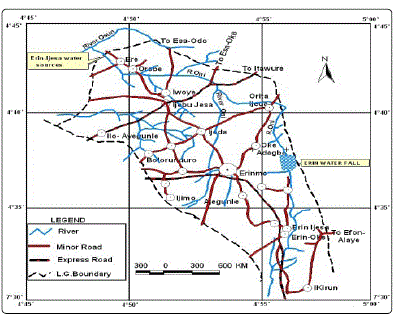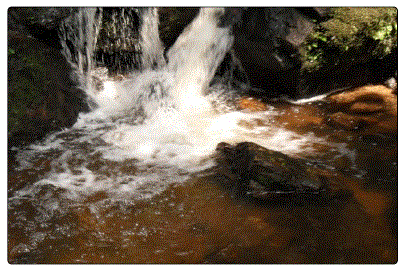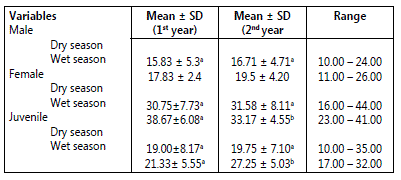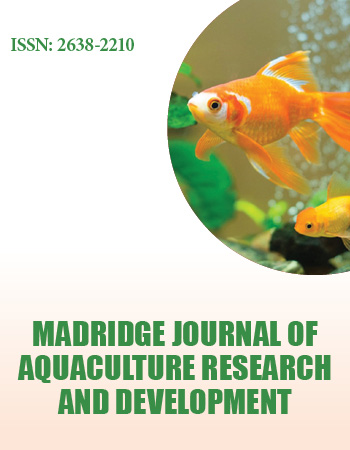Research Article
Water quality parameters of Olumirin waterfall in relation to availability of Caridina africana (Kingsley, 1822) in Erin-Ijesa, Nigeria
1Department of Agricultural Science, Osun State College of Education, Ilesa, Osun State, Nigeria
2Department of Fisheries and Aquaculture Technology, Federal University of Technology, Akure, Nigeria
3Department of Fisheries and Aquaculture Management, Ekiti State University, Ado-Ekiti, Ekiti State, Nigeria
*Corresponding author: Funmilayo Bosede Oyekanmi, Department of Agricultural Science, Osun State College of Education, Nigeria, Email: fumboye17@yahoo.com
Received: April 4, 2017 Accepted: April 24, 2017 Published: April 29, 2017
Citation: Oyekanmi FB, Bello-Olusoji OA, Akin-Obasola BJ. Water quality parameters of Olumirin waterfall in relation to availability of Caridina africana (Kingsley, 1822) in Erin-Ijesa, Nigeria. Madridge J Aquac Res Dev. 2017; 1(1): 8-12. doi: 10.18689/mjard-1000102
Copyright: © 2017 The Author(s). This work is licensed under a Creative Commons Attribution 4.0 International License, which permits unrestricted use, distribution, and reproduction in any medium, provided the original work is properly cited.
Abstract
The water parameters of Erin-Ijesa waterfalls and the abundance of Caridina africana were studied for two consecutive seasons. Water and prawn sampling were carried out bi-weekly. Prawns were collected with scoop and hand nets. Transported to the laboratory for examination for further analysis.. the physicochemical parameters of the water sample collected were determined using standard methods, the following parameters were determined; temperature (°C), conductivity (µohms/cm), pH, alkalinity, Population index of the prawns such as frequency of occurrence, relative abundance, sex ratio, male:female ratio, index of occurrence were determined. Prawn number, sex and age were more during the wet season with a peak in August. Both adults and juveniles showed a progressive increase from November to August. The results shows that average water Temperature was
27.77 ± 2.27°C, Transparency 1.71±0.39m, Depth 1.43±0.22m, Dissolved Oxygen
6.21±0.77mg/l, pH 7.25±0.68, Alkalinity 136.62±41.6mg/l, Total Dissolved Solid
402.13±253.25mg/l, Conductivity 83.40±1.86µohms/cm, Nitrate 4.76±0.76mg/l and phosphate 0.28±0.05mg/l. Erin-Ijesa waterfalls exhibited features that are typical of tropical environment, which fell within a range that can support aquatic life. High value in Condition factor for C. africana revealed the adaptability and total well being of the specie despite the unstable nature of the waterfalls.
Keywords: Water quality parameters; Erin-Ijesa waterfalls; Caridina africana; Abundance.
Introduction
More than 90% of crustaceans consumed in Nigeria are obtained from capture fisheries, mostly from artisanal, coastal and fresh water fisheries [26, 20]. There are many species of recast of prawns and shrimps which inhabit water bodies of Nigeria. There are many fresh water prawns of economic importance which have been identified as suitable species for aquaculture [29]. Caridina is generally unexploited except in special situations where it is easily captured in huge numbers with fine-meshed nets or baskets. The species is harvested annually from the vegetation in lakes in the central part of the Delta. Fine-meshed nets are used, and the fresh prawns are pounded into a paste which is wrapped in leaves and cooked as a cake. Holthuis (1980). Women catch them in hand nets along river banks near Kisangani. According to Powell (1982), the species shows much geographic variation in morphology [29]. Delta populations differ from those in other parts of Nigeria; they probably represent a distinct subspecies and may also include a second species. Scattered ecological references exist for West Africa [29] Caridina. africana are small in size ranging between 17.0-
30.1mm. The pleuron of the second abdominal segments overlaps those of the first and third segments. There are five pairs of walking legs (periopods) and the first and second legs (chelipeds) are shorter than the other three pairs of walking legs. The periopods bears hair like projections at the tip of the periopods. There are 5 pairs swimmerets (pleopods) each having hair like projections (bristles or satae) unto which the eggs are attached in the brood chamber on the underside of the abdominal regions. The uropod and telson have hair-like projections which are called brushes of setae, around their edges. The antenna, flagellum antennule, pereopod, cheliped, pleopod, uropod, telson and abdomen are visible under the microscope. Colour of live prawn is white; however, the colour changes based on substratum background.
This study is imperative for assessing the productivity and suitability of C. africana for rearing. The literature available on limnology of lakes, rivers, streams, reservoirs and waterfalls in Nigeria is vast [24]. However, there has been little attempt to study and monitor the bio-ecological features and suitability of Waterfalls in relation to prawn production. This therefore investigates the water quality parameters of Erin –Ijesa waterfalls as it affect the growth and well being of Caridina africana (Rocky waterfall prawn) as a pre-requisite to their culture.
Methodology
Description of Study Areas: Olumirin waterfalls is situated in Oriade Local Government Area of Osun State within latitude 70 30ʼ and 80 45ʼ North and longitude 40 31ʼand 50 East. (Fig.2). the waterfall is located two kilometers off Erin-Ijesa town. Olumirin waterfalls have about seven layers and only few visitors can climb beyond the second layer. The area can also serve for mountain hiking. The water flows among the rock and splashes down with great force to the evergreen vegetation around. The water also collects in the form of ponds at the bottom of each layer. The area is ideal for tourism and recreational activities.

Figure 1: Map showing Erin-Ijesa town

Figure 2: Map showing Erin-Ijesa town
Determination of water quality Parameters
Physical and chemical water quality parameters were done bi-weekly.
Physical parameters
Temperature was measured to the nearest 0.1oC with mercury in-glass thermometer at about 10cm below the water surface. Transparency was measured with a 15cm diameter white and black secchi disc to the nearest 0.1m. Depth was determined by using a lead sinker attached to a calibrated rope. The sinker was lowered until it reached the floor of the water. pH of water samples was determined in the laboratory using Kent pH meter 7020. Dissolved Oxygen was determined using Winkler titrimetric method [7]. Alkalinity was also determined according to APHA [7]. Conductivity of the water samples was measured in mohms/cm by using the HACH Conductivity meter probe. Total Dissolved Solid was calculated from the conductivity reading obtained. The conversion factor given in HACH conductivity meter was used to multiply the conductivity values, the values were multiplied by 0.7 [7]. Nitrate concentration was determined by using phenyl di-sulphuric acid as described by APHA (1985) [7]. Phosphate was determined by the ascorbic acid method according to APHA (1985) [7].
Collection of Prawns
Scoop and hand nets were used to collect C. africana at Olumirin waterfalls. The tiny prawns harvested were conveyed in 80 litres circular container, 75% filled with the natural water of the environment where they were obtained and transported with the use of aerator to the laboratory for examination. Water samples were collected separately for physical and chemical water quality parameter assessment.
Laboratory Analysis
In the laboratory, prawns were counted, sorted into species, age, and sexes and identified based on the taxonomickeys prepared by Reed et.al. (1967) and Lowe-Mc.Connell (1972) [30, 25]. Sexes of prawns were determined by visual examination of the second pleopods or chelipeds at the sides of the carapace as described by Powell (1982) [7]. The confirmation of male sex was by the presence of the appendix masculina in the second chelipeds also the genital pores are underneath the body at the base of the third pair of leg in the female (thelycum) and a gonopore at the base of the fifth pair of leg in the male (Patasma) [16].
Statistical Analysis
The relationships between the physical and chemical parameters were computed using linear regression routine of the SPSS 1.5 and Microsoft Excel. One-Way Analysis of Variance (ANOVA) followed by Duncan New Multiple Range Test (DMRT) and Student T –test were used to compute results of the findings.
Results and Discussion
The results of the parameters of Olumirin waterfalls, Erin-
Ijesa during the period of study are presented in Table 1. There are two distinct seasons, wet and dry seasons. Ayoade et al, (2006) stated that in the tropics, where the different seasons are not clearly demarcated, the amount and type of rainfall may play a significant part in regulating the various seasonal biological rhythm [11]. The variations in chemical conditions of freshwater ponds have generally been found to be due to effects of rainfall [13]. Rainfall influences the amount of discharge into river and consequently into the lake. It has been pointed out that rainfall affects water quality at Asejire Lake and Warri River [9, 19]. Thus, due to the effect of rainfall on water level, physical and chemical parameter of lakes, the differences in the amount and duration of rainfall may likely cause differences in physical and chemical parameters at different time of the year may affect prawn growth and production. Lower atmospheric temperatures were recorded in the rainy season. This may be associated with rainfall and relative humidity which were higher during rainy season, thus lowering the atmospheric temperature. However, lower water temperatures were observed in Olumirin waterfalls in January (22.0oC) and November (24.0oC). This could be due to the harmattan and the rocky and shady environment.
Depth of the water is shallow in Olumirin waterfalls; this allows the insolation of light to the water bottom thereby boosting primary productivity of phytoplanktons. In aquatic ecosystem dynamics, light penetration and water depth influences the rate of photosynthetic activities which in turn can change the amount of dissolved oxygen in the water. This observation agrees with the view of Adeniji (1990) who stated that photosynthesis is limited to only the top 1m depth of water [2]. Smith and Swingle (1983) also showed a positive relationship between plankton abundance and fish production in pond [31]. However, low temperature in some times of the season could be due to the regular splashes of water from the rocks to the ponds at the bottom of each waterfall which possibly reduced the water temperature. The lowest water level recorded coincided with period when little or no rainfall occurred. Highest water level recorded showed that intensity of rainfall varies from one sampling site to another. The inverse relationship between transparency and rainfall in this study agrees with those of Egborge (1977) in some Nigerian freshwaters [17]. Means transparency values of 1.43m ± 0.22
were observed in the study area, this value was almost similar to values documented by Ugwumba and Ugwumba (1993) [33]. This shows that during the dry season the water contains adequate nutrients hence itʼs being fairly turbid [33]. The higher dry season secchi-disc transparency mean values compared with the wet season values could be due to the absence of flood water, surface run-off and settling effect of suspended matter which resulted from lack of rainfall.
pH in Olumirin waterfalls was 7.25 ± 0.68, making these waters very good for prawn production, Boyd and Lichtkoppler (1979) reported that waters with pH range of 5.5 to 9.0 are most suitable for fish production [14]. High mean values in pH could be due to combined effects of greater water volume and rocky landscape at Erin-Ijesa waterfalls that could produce high calcium carbonate effluent contents which increased the pH. On the other hand, the lower pH value could be as a result of high acid content of organic effluents.
Dissolved oxygen concentration was high because the water body is a lotic water. The water has high velocity which generates the ripple that could eventually increase the Dissolved oxygen content. This might be responsible for the observed high oxygen content. In addition, dissolved oxygen content in the water could be high as a result of phytoplankton density in Olumirin waterfalls which is also shallow. In general, a maximum of 8.90 mg/l dissolved oxygen concentration was recorded, although less than this value, as low as 5 mg/l dissolved oxygen would be satisfactory limit for most of the processes required for a successful prawn survival. Since the oxygen of the natural habitat is high, it could mean that the prawn would require relatively high dissolved oxygen content when cultured. However, this is contrary to the observation of Marioghae (1987) who reported that M. vollenhovenii could survive in water with low dissolved oxygen of 2.0mg/l [27].
Seasonal variation in values of Total Dissolved Solids (TDS) could be as a result of dilution from rainfall since lower values were recorded during the wet season mainly between June and October when the rainfall was at its peak. The observation that higher TDS values were recorded during the dry season months (March to May) were supported by Egborge (1977) and Adeniji, (1994) that water temperature affect TDS. According to both scholars, a rise in temperature also results in a corresponding increase in the concentration of TDS [17, 3].
Nitrate values ranged from 3.42-6.66mg/l while phosphate ranged from 0.13-0.36mg/l. Adeosun (2007) in his study observed that the concentration of nitrate in Ikere Gorge ranged between 3.25-7.1mg/l and phosphate ranged between
0.14-3.7mg/l [4]. The nitrate values were low and phosphate high when compared to the recommended concentrations of
10mg/l and 0.005mg/l respectively for nitrate and phosphate in drinking water for human by world health organization. According to Ikenweiwe (2005), the values recoded for nitrogen and phosphorus in Oyan lake were higher ranging between 41.10 – 62.64mg/l and 0.64 – 0.88mg/l respectively. Phosphorus and nitrogen are known to play major role in biological metabolism of aquatic plant notably phytoplankton and macrophyte [34].
The conductivity value ranged between 80.00-86.80 mg/l (Mean=83.40 ± 1.86 mg/l). The larger the conductance, the more mineralized the water [27]. The conductivity of water was observed to be higher during the period of higher temperature when the dissolved oxygen was lower. This is also in accordance with the observation of [11] in their work on the limnology of two man-made lakes. It was reported that the distribution patterns of conductivity were in several respect mirror images with those of the temperatures.
Table 1: Range and Mean Values of Physical and Chemical Parameters of Erin-Ijesa Waterfalls

*Same superscripts along the row indicated that there are no significant difference at p>0.05.
Prawn Abundance
The relationship between prawn abundance and water parameters in this study showed that no single parameter can be singled out in relation to prawn species composition and abundance. However, temperature, transparency, dissolved oxygen, pH and depth when kept at optimal level can guarantee high prawn yield.
The seasonal abundance of C.africana revealed that the highest prawn catch was recorded in wet season irrespective of the stage of development and sex but the lowest seasonal abundance occurs during the dry season. The abundance of juveniles was more during the wet season than the dry season. However the abundance of adult C.africana was not affected by season. This is further illustrated in Table 2
Table 2: Seasonal Mean Values and Range of Abundance of C. africana

*Same superscripts along the row indicated that they are not significantly different at p>0.05.
Conclusion and Recommendation
Olumirin water fall exhibited features that are typical of tropical environment. The physical and chemical parameters observed for the water body were within the range that can support aquatic life [14] [10]. This could be responsible for the success of these species in their habitat. The rise in condition factor values for the species under investigation shows the total well being of the prawns and suitability of the environment for prawn sustainability. The water chemistry was influenced principally by physical and chemical nature of inflows into it and also of the submerged vegetation and soils [18]. Spatial and seasonal variations in the water quality parameters may bring about variations in the quality and quantity of prawns obtained. These marked variations were observed between samples, sites, months and seasons as they affect prawn resources within the study areas.
The following recommendations were made in accordance with the findings:
• The results of this research can be used as baseline in
commencing their production in artificial environment
• Production of C. africana should be encouraged in order to get its full potential for sustainable development and poverty alleviation.
• There is need to cage-culture C. africana in its natural environment at the initial stage, providing artificial feeds so as to improve the size.
• The economic viability of freshwater prawn farming in Nigeria should be investigated.
• Olumirin waterfalls should be protected from destruction as a result of human activities so as to prevent the specie from going into extinction because C. africana is habitat specific.
Conflict of Interest
The authors confirm that there is no conflict of interest regarding this manuscript.
References
- Adebisi AA. The physicochemical hydrology of a tropical seasonal riverupper Ogun River. Hydrobiologia. 1981; 79(2): 157-165. doi: 10.1007/ bf00006123
- Adeniyi H A and Mbagwu IG. Study of physco chemical characteristics of some heavy metals in jankara Reservoir, Kano State, NIFFR Annual report. 1990; 136-140.
- Adeniji HA, Ovie SI. A simple guide to water quality management in fish ponds. NIFFR, report series NO 23. 1994.
- Adeosun FI. Bio-ecology of the fishe fauna of Ikere Gorge in Oyo State, Nigeria, Ph.D thesis. 2007; 112.
- Akegbejo-Samsons Y. Ecology of the Fisheries Resources of Coastal Wetland of Ondo State and Its Management Implications Ph.D. Thesis, Federal University of Technology, Akure. 1995; 287.
- Akintola SI, Anetekhai MA, Fakoya KA and Adewolu NA. Seasonal distribution and aspects of biology of Genus Macrobrachium from Badagry Creek in Nigeria. Nigerian Journal of Fisheries. 2010; 7(1&2): 16-24.
- APHA. Standard Methods for the Examination of water and waste water. 15th Edition. American Pub. Health. Assoc. Wshington. D.C. 1985; 1134.
- Amadi G. Shrimp Affair, Nigeria Business Magazine.1991
- Anetekhai MA. Aspects of the bio-ecology of the African River Prawn Macrobrachium vollenhovenii (Herklots) in Asejire Lake, Oyo State, Nigeria. Ph.D Thesis, University of Ibadan, 1986; 225.
- Aquacop. Macrobrachium rosenbergii culture in Polybesia. Progress in developing a mass intensive larval rearing technique in clear water. J. world. Aquac Soc. 1977; 8(1-4): 311-326. doi: 10.1111/j.1749-7345.1977. tb00127.x
- Ayoade AA, Fagade SO and Adebisi AA. Dynamics of limnological features of two Man-made lakes in relation to Fish production. African. J. Biotech. 2006
- Balogun AM, and Akegbejo-Samsons Y. Waster yield, proximate and mineral composition of Shrimp Resources of Nigerian Coastal waters. Bioresou Tech. 1992; 40(2): 157-161. doi: 10.1016/0960-8524(92)90202- 9
- Bello-Olusoji OA, Bankole M, Sheu A, Oyekanmi FB. Availability, diet composition and feeding behavior of some commercially important palaemonidae prawns in fresh and brackish water of Nigeria. J. biol. sci. 2006; 6(1): 15-21. doi: 10.3923/jbs.2006.15.21
- Boyd CE, Lichtkoppler. Water quality management in pond fishculture. Research and Development series NO 23. International center for aquaculture, agricultural experimental station, Auburn University, Auburn, Alabama.1979.
- Cook BD, Bunn SE, Hughes. Generic Structure and Dispersal of Macrobrachium australiense (Decapoda; Palaemonidae) in the Western Queensland, Australia. Fresh water Biol. 2002; 47: 2098-2112
- Edokpayi CA. Biology of Prawns (Crustacea: Decapoda: Natantia) in Benin River at Koko, Bendel State. Ph D Thesis University of Benin. Nigeria. 1990.
- Egborge ABM. The hydrology and plankton of the Asejire Lake. Ph.D Thesis. University of Ibadan, Ibadan. 1977; 278.
- Egborge ABM. Observations of the vertical distribution of the zooplankton in the lake Asejire- A new impoundment in Nigeria. Proc. Int. confr. Kanji lake and River basins development in Africa. Ibadan. 1979; 11-17 dec. 1977: 208-218.
- Egborge ABM. Biodiversity and Chemistry of Warm River. In: Water Pollution in Nigeria (Vol. 1) Ben Miller Books. p. 331. 1994
- F A O. Yield and nutritional value of the commercially more important fish species.1996
- F.A.O. Fishery Tech. Paper No. 309 Rome 187.
- Ikenweiwe NB. Limnology and Plankton Abundance in relation to fish production in Oyan lake, South-Western Nigerian Ph.D thesis. 2005; 135.
- Imevbore AMA. Some general features of Kainji Lake Basin, Kainji Lake studies. Ecology 1970; 1: 17-26.
- 24. Ita EO. A review of recent advances in warm water Aquaculture research and proposal experimental design for maximizing fish production in Nigeria. KLRI Technical series No. 5. 1982.
- Lowel-McConnell. Freshwater fishes of the Volta and Kainji lakes, Accra, Ghana, University Press. 1972.
- Marioghae IE. Notes on the Biology and distribution of Macrobrachium vollenhovenii and Macrobrachium Macrobrachion in the Lagos laggon. Rev. Zool. Afr.1982; 96(3):493-508.
- Marioghae IE. An Appraisal of the Cultivability of Nigerian palaemonid Prawns ARAC/87/WP/4. 1987
- McNeely RN, Neimanis VP, Dowyer L .Water quality source book: A guide to water quality parameters and a soft water stream in southern England. J. Fish. Biol. 1979; 1: 31-44.
- Powell CB. Fresh and brackish water shrimps of economic importance in the Niger Delta. In proceedings of the 2nd Annual Conference of Fisheries Society of Nigeria (FISON). Kainji Lake Research Institute, New Bussa. 1982; 254 - 285.
- Reed W, Buchard J, Hopson AJ, Jenness J, Yaro I. Fish and Fisheries of Northern Nigeria. Ministry of Agriculture, Zaria. 1967; 262.
- Smith EV, Swingle HS. The relationship between plankton production and fish production ponds. Trans. Amer. Fish. Soc. 2011; 1939(68): 309- 315. doi: 10.1577/1548-8659(1938)68.
- Ugwumba AO, and Uguwumba AAA. A Study of the physico–chemical, Hydrology and Plankton of Awba Lake in Ibadan, Nigeria. Fish Acadbiz comm. 1993; 1(1-4): 20–39.
- Wetzel R G. Limnology Philadelphia; Saunders. 1983; 743.
- Wallace R.Shrimps in Alabama. Fille:A.shrimpinalabama.htm, 4. 1997.


